
May, 01, 2006
Vineyard Style Magazine
Wonderous Water Works The Mindful Music of Marcia Smilack
written by John Budris

Marcia
Smilack made the sojourn from words to images much in the same way as
most of her life’s conduct. She let intuition surrender to the work of
paying her bills and watched where the pieces fell. And then followed.
She did not even think of herself as a visual artist until a
recuperative rental atop Menemsha Harbor found her taking snapshots of
the wavering water one sundown. At that precise moment some 15 years
ago, she was still a writer-in-recovery, with an Ivy League doctorate
and burgeoning teaching career, a folio of magazine articles, and an
incomplete memoir about the women of the Vietnam War, the combat nurses
who were saviors in scrubs.
Marcia’s research, like anything she does, was a swan dive into
the lives and minds of her subjects. Knotting herself in the
war-inside-the-war stories of one nurse – whom she says was as much
savage as savior – left Marcia’s brain clinically addled. With dark
humor, she describes her condition akin to the village sineater with
indigestion and an appetite insatiable.
The custom of the sin-eater was
once common in England and the Scottish highlands during the Middle
Ages. Each town had its official sineater to whom notice was given as
soon as a death occurred. The sin-eater would devour a symbolic meal –
often bread on the breast of the corpse – as a means to cleanse the
soul of the dead and allow entrance into the next world. Listening to
the Vietnam nurses’ secret stories of horror and tragedy, of
unimaginable physical and psychic pain – told for the first time – was
for them a healing release. Marcia was their contemporary sin-eater,
hearing their confessions, her attention their absolution.
"But as one combat nurse told me, I then caught it myself, like some
brain virus I could not shake, and I became physically hostage to it –
their experiences, their consciousnesses – became my own. I screamed
their wails in my dreams,” she says.
Hospitalized at the Massachusetts General with meningitis and her left
side paralyzed, Marcia’s neurologist spoke frankly: “Stop whatever you
are doing or you will die.” She obeyed. That time in Menemsha was
haven, harbor and intersection, her Vietnam book at ebb, her dance with
the camera about to flood.
“I was mesmerized by the red buoys on board the boats. At that time of
day, with the sun shining directly on them, a powerful set of
reflections is produced that elicits a sound I can only as that of a
siren – not a loud annoying siren, but a Siren like the ones in Ulysses
– a sound that neither he nor I could resist,” she says. Camera in tow,
she walked to the harbor and took her first photographs of red buoys,
hearing the scarlet hues when she snapped the shutter.
“The reflections on the surface of the sea stimulate my synesthesia. I
found myself literally unable to keep my lens above sea level; I’d try
to take normal pictures but before I knew it, I’d be aiming below, down
at the water no matter what my intention,” she says. This first
compulsion to document, in photographs, the source of these synesthetic
responses has morphed into a 15-year art form. That same fall dozens of
snapshots multiplied into hundreds, most of which Marcia tacked on her
wall. Without her even knowing, neighbor Virginia Poole escorted
friends and visitors to see what she presumed was a study of the flux
of the tides.
“They had no idea that my eyes and ears and camera were chasing the reflected images on the surface of the water,” she says.
Marcia is a synesthete, a term describing those who have multiple
sensory reactions to single stimulations. In other words, she sees
sound in shapes and color, and visual stimuli excite her sense of sound.
“When I look at reflections on water, I experience texture and motion
responses. I use these responses to create my work,” she says. “In
fact, that’s how I taught myself to use a camera. I simply shoot at the
moment I have a synesthetic response.” Her prompt to snap the shutter
is more guided by that internal crescendo of sound rather than what
floods through the lens. She’s dubbed herself a reflectionist since the
essence of her photographs is a harvest of bent light rebounding off
the water. “I use the surface of the sea as my canvas, the wind for my
brushes, and rely on season and location to produce my palette,” she
says. Nothing is shaped with a digital slight-of-hand or Photoshop
abracadabra. “I never manipulate the water, or change a picture after I
take it. Why would I when my goal is to capture on film what nature
already provides,” she says. What her eyes and mind see and hear, is
what the lens yields. The only exception is the occasional tight crop.
Her printing technique is likewise straightforward. Smaller works she
runs through a generous ink-jet printer; the larger pieces are created
with the Gicleé method. But each image is a gentle stop sign, requiring
the viewer to surrender a moment. Her work forces, cajoles, invites,
and seduces a certain halt. The images whisper, like a scent, some
homing instinct, bidding a delve deeper into what the eye sees to what
the consciousness begs.
You cannot simply pass by a Marcia Smilack image any more than you
could ignore your own nude self-portrait hanging on a stranger’s
bedroom wall. Each reaches out and asks a response. Ponder one for a
grateful moment too long, and like Alice drawn within the looking
glass, one emerges curiouser and curiouser.
ABOUT SYNESTHESIA
The Warrens of Consciousness
Synesthesia:
(Greek, syn = together + aisthesis = perception)
Synesthesia is the involuntary physical
experience of a cross-modal association. That
is, synesthesia occurs when the stimulation of
one sensory modality reliably causes a
perception in another different one.
The first time Marcia Smilack heard the word synesthesia, she frolicked
in a laundromat. She believed she was alone, which perhaps explains why
she was dancing with aboriginal abandon to the percussion of the dryer.
To her mortification, she turned around
and saw a woman had been
studying her for quite some time. “I believe you may be synesthetic,”
she told Marcia. The woman was a graduate student in psychology who had
just read about synesthesia. “I may be what?” Marcia asked,
incredulously. The doctoral student went on to explain that synesthesia
was a rare, but well-documented condition that manifests with multiple, sensory
reactions to a single visual or auditory source. In other words, she
said, some synesthetes see sound and hear color because those parts of
the brain are activated simultaneously. A synesthete might claim to be
able to hear colors, taste shapes, describe the color, shape, and
flavor of someone’s voice or music, the sound of which looks like
anything from “shards of glass” to “melted chocolate” and anything in between.
Her definition resonated with Marcia, because she heard herself
silently conclude, “that would explain why the first note I played on
the piano was green.” Marcia had never told anyone about that
experience, or the fact that she sees everything she hears.When Marcia
decided to do a little research, she did not get very far.
“
When I found Synesthesia listed in a medical dictionary between
Seizures and Syphilis, I quickly lost my enthusiasm and forgot about it
for another 20 years,” she says. In 1996 a New York Times story about
synesthesia caught her eye and put into words something she’d been
living all her life. That introduction began for her a ten-year study
of synesthesia, which included her many lectures on the subject at
universities and conferences.
Some describe the sensation in pejorative terms, calling synesthesia a
confusion of the senses. A host of notable artists and writers have
claimed to suffer from synesthesia, including, Arthur Rimbaud, Wassily
Kandinsky, Vladimir Nabokov, and David Hockney. Once dismissed as mere,
“romantic neurology and neurosis,” contemporary medicine has vindicated
the believers. With the advent of sophisticated brain scans, especially
Positron Emission Tomography (PET), neuroscientists can now confirm
what psychologists once postulated about synesthesia. When subjected to
sound, language or visual stimuli while undergoing a PET scan, the
brain centers of most people will “light up” in the appropriate places.
With synesthetes, a single stimulus often induces the brain to light up
like a Christmas tree, indicating that the subject is experiencing a
far richer and textured response. The phenomenon is also common with
mathematics prodigies.
Vineyard Style
Marcia Smilack
IN HER OWN WORDS
All of my photographs are reflections on moving water. I collaborate
with nature to create what I call Paintings by Camera. I use the
surface of the sea as my canvas. I have only one chance to capture an
image before it morphs into another so I am at the mercy of whatever
nature decides to give me that day. I am like a fisherman who goes
looking for the place where the blues are running or the yellows or the
reds, and the images I reel in are always a surprise, which is how I
like it. People often ask if I manipulate the water, but why would I
when the whole point is to be surprised? The thrill for me is to leave
my house without a clue of what I will find when I put on my eyes that
day. Manipulating the water would take away the element of discovery
which would make the art go away. I never manipulate the image after I
take it either.
The way I taught myself photography was to shoot whenever I heard a
chord of color, which is one of my synesthetic responses to what I see.
I knew nothing about photography at the time, so I decided to instead
simply trust what I ‘hear’ in my mind’s eye. I use my synesthetic
responses as reliable signals that tell me when to shoot a picture. For
example, at the moment that the color I am staring at creates the sound
of cello, which for me is not a metaphor, but rather the way I perceive
the world, I shoot. I was 25 years old before I understood that
everyone does not perceive the world as I do. I hear with my eyes and
see with my ears.
The first note I played on the piano was green. I experience colorsound
synesthesia in both directions. The other synesthetic responses I use
in my artwork include texture, motion, and taste. I take pictures when
what I am looking at produces the sensation of satin against my skin,
creates the sensation of dancing or in one case, produces the taste of
ice cream.
I dream many of my images before I see them on the water and often feel
like a reporter from the Collective Unconscious. I stand poised at the
edge of a floating tableau of reflections that pass by whether anyone
notices them or not. Collected, these archetypal images form a
universal alphabet. Tide to tide, the sea’s mirrored surface washes up
to and over the sea-land barrier like a cerebral moat, as if the
universe is dreaming. And while reflected images, like dreams, cannot
be repeated, unlike dreams, they can be recorded. I go fishing for
archetypes and the catch I bring home – the dreams of the universe –
belongs to us all.
by Marcia Smilack
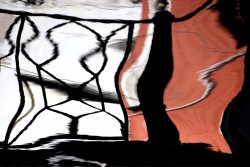
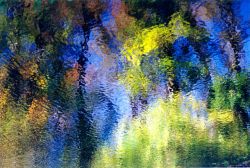
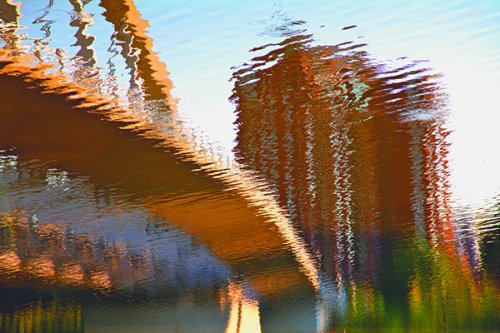



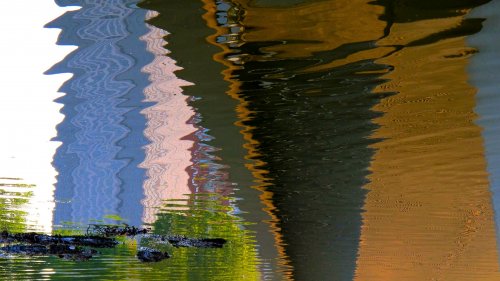
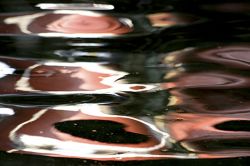

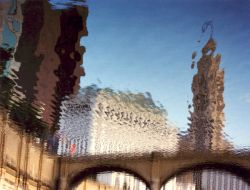

 Marcia
Smilack made the sojourn from words to images much in the same way as
most of her life’s conduct. She let intuition surrender to the work of
paying her bills and watched where the pieces fell. And then followed.
Marcia
Smilack made the sojourn from words to images much in the same way as
most of her life’s conduct. She let intuition surrender to the work of
paying her bills and watched where the pieces fell. And then followed.